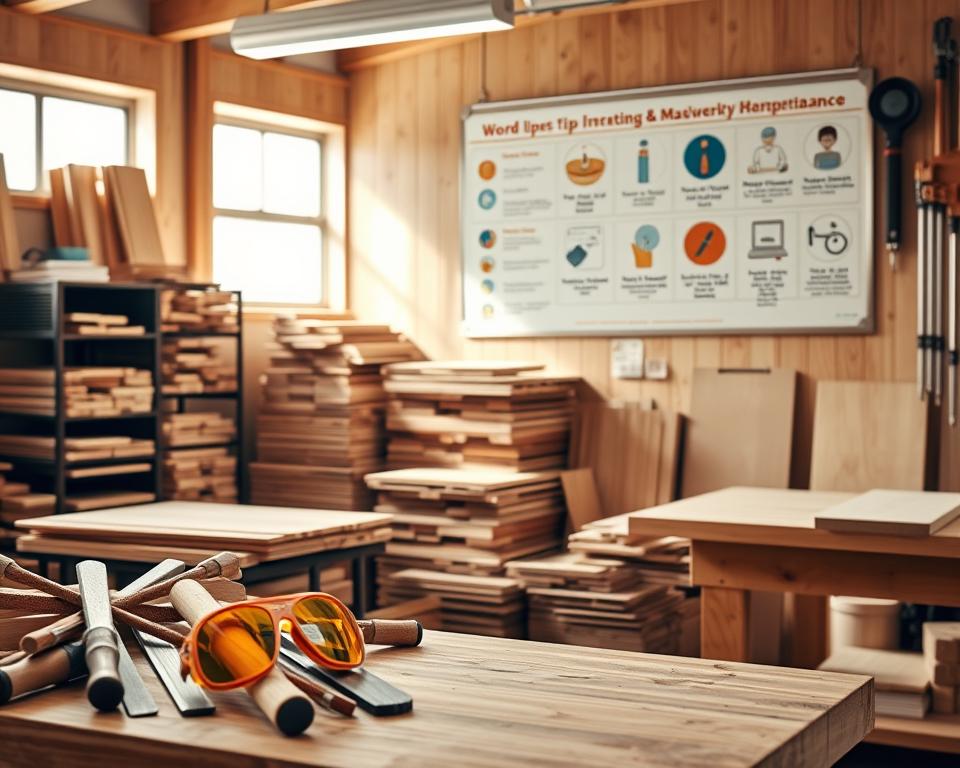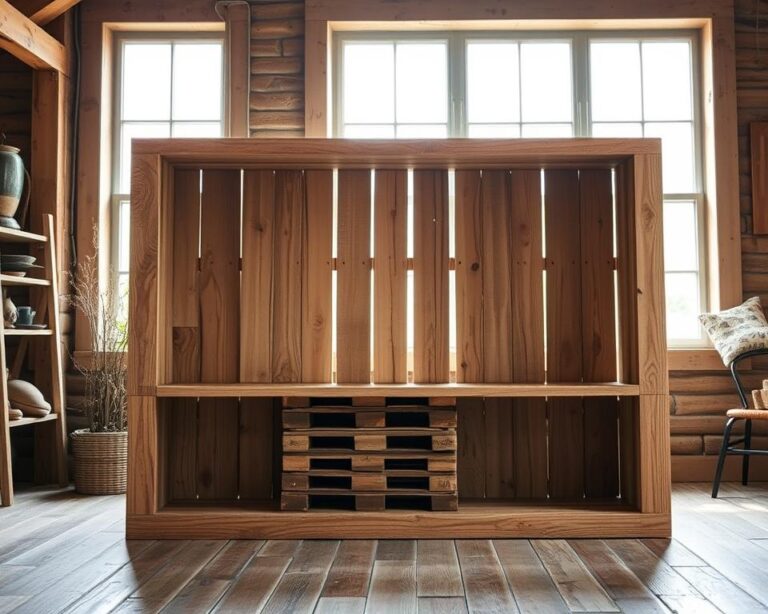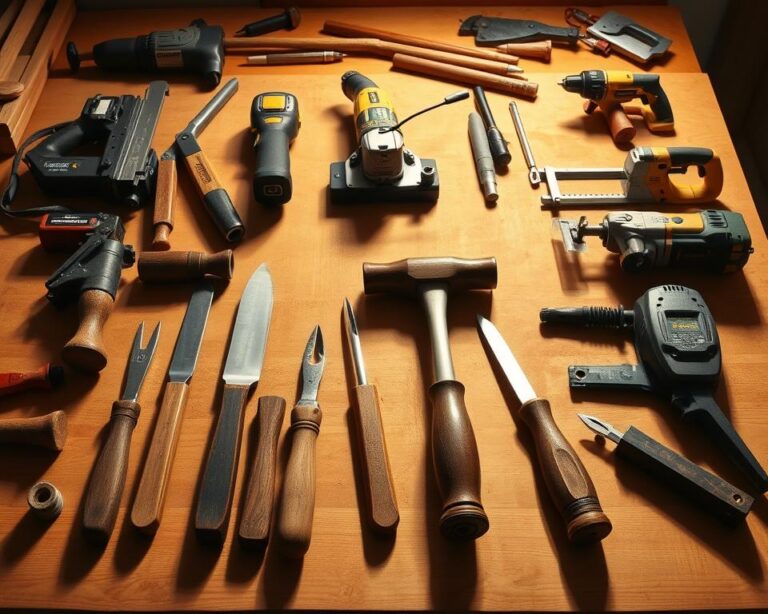Did you know over 400,000 hospital visits in the United States each year are from woodworking injuries? As an amateur woodworker, knowing how to stay safe is crucial. It can turn your hobby into a fun and safe activity. Whether you make gifts for loved ones or sell your crafts, safety is key.
This guide will help you learn how to stay safe while woodworking. It’s all about preventing injuries and improving your skills. By focusing on safety, you’ll enjoy making your projects more and worry less about accidents.
Understanding Woodworking Hazards
Woodworking can be fun and rewarding. But, it also has dangers that beginners need to know. Knowing these risks helps keep you safe while making beautiful projects.
Common Risks in Woodworking
Woodworking involves sharp tools and heavy materials. Some common dangers are:
- Cuts and lacerations from saw blades
- Kickback incidents from power tools
- Inhaling wood dust
Many people get hurt from saws each year. Knowing how to use tools safely can lower injury risks.
Potential Personal Injuries
Keeping yourself safe is key in woodworking. Serious injuries include:
- Finger amputations
- Eye injuries from flying debris
- Respiratory issues from inhaling harmful particles
Using safe wood and finishes protects you and your family. Choosing the right materials is important. For example, look into safe wood options for kids’ toys.
Environmental Concerns
Woodworking can release harmful dust and particles. This affects both you and the environment. Using dust control systems is vital for a clean workspace.
Essential Safety Gear for Amateurs
Safety gear is key in woodworking. It greatly lowers injury risk, letting you enjoy your projects more. Knowing which gear to use keeps your workspace safe and fun.
Importance of Personal Protective Equipment (PPE)
Personal protective equipment acts as a shield against dangers. Safety glasses protect your eyes from debris. Respiratory masks keep dust out of your lungs. Choosing brands like 3M ensures top-notch protection, making your workshop safer.
Recommended Gear for Woodworking Projects
Here are some must-haves:
- Safety glasses for eye protection
- Respiratory masks to filter airborne particles
- Ear protection to reduce noise levels
- Gloves for hand safety and grip
This gear is vital, especially with power tools. They can kick up dust and be loud. Each piece of your PPE should be carefully chosen for the best protection.
How to Properly Use Safety Equipment
Using safety gear right is crucial. Always wear your glasses and gloves first. Make sure masks fit well to block dust. Check your gear often for damage and replace it when needed.
This care keeps you safe and helps you work better. It’s all about protecting your health and enjoying your craft.
Preparing Your Work Area
Creating an organized woodworking shop is key for safety and efficiency. A tidy work area lets you concentrate on your projects without distractions. It’s important to have both organization and good lighting for precision and safety.
Organizing Your Workspace
To make your woodworking shop organized, try these tips:
- Set up specific spots for tools and materials.
- Use wall-mounted racks and shelves to save space.
- Keep your work surfaces clean to avoid tripping.
Importance of Adequate Lighting
Good lighting for woodworking projects makes things clearer and cuts down on errors. Put in bright, adjustable lights to light up your work without shadows. Natural light is great, so place your setup near windows if you can.
Make sure you have:
- Task lighting for detailed work.
- Ambient lighting to light up the whole area.
Keeping Tools Within Reach
Having all your tools within easy reach is part of a safe workspace. Put your most used tools at waist height and close by. This makes work more efficient and reduces the chance of accidents. Think about using:
- Toolboxes or carts for easy moving.
- Magnetic strips for quick access to small tools.
Tool Safety Basics
Knowing how to use tools safely is key for woodworkers. Learning about your tools helps you stay safe and enjoy woodworking more. It’s important to understand safe tool use and the rules for power and hand tools.
Understanding Your Tools
Every tool in your workshop has its own job and risks. Whether it’s a power tool like a circular saw or a hand tool like a chisel, knowing how to use it is crucial. Always read the instructions from the maker. This knowledge helps you use tools safely and avoid risks.
Using Power Tools Safely
Power tools are handy but need extra care. Follow these tips for safer power tool use:
- Always use the right guard mechanisms.
- Keep blades sharp and well-maintained for clean cuts.
- Stay focused and avoid distractions while using these tools.
- Wear protective eyewear and ear protection as needed.
- Turn off tools from power sources when changing blades or making adjustments.
Hand Tool Safety Tips
Hand tools might seem safer, but they need care too. Here are important hand tool safety tips:
- Use tools only for their intended purpose.
- Keep cutting edges sharp to prevent slips.
- Keep your workspace clean to avoid accidents.
- Use both hands for control whenever possible.
- Store tools properly after use to prevent accidents.
Best Practices for Cutting Wood
Cutting wood is key in woodworking. Learning the right techniques can make your projects better. You need the right tools and to be precise. Knowing the best practices can improve your work and help you avoid mistakes.
Techniques for Accurate Cuts
Using top-notch measuring tools is crucial. Tools like tape measures or squares help make cuts straight. They also help in planning your design.
Before cutting, mark the wood clearly and know the grain direction. This improves your accuracy. It’s important to control the tool, whether it’s a saw or router, and apply steady pressure.
Common Cutting Mistakes to Avoid
Many woodworkers face problems when they don’t secure the workpiece well. Not clamping the wood can cause bad cuts and safety risks. Another mistake is getting the measurements wrong, wasting materials and time.
Double-checking your work can avoid these issues. It saves time and materials, and keeps you safe.
Importance of Measuring Twice
The saying “measure twice, cut once” is true. Double-checking your measurements saves materials and keeps you safe. It makes your work more efficient and reduces errors.
Proper Wood Handling Techniques
Learning the basics of wood handling safety is key to avoiding injuries when working with lumber. By using the right techniques, you can make woodworking safer. Focus on lifting wood correctly, stabilizing big panels, and watching out for pinch points in your projects.
Lifting and Carrying Wood Safely
When lifting wood, use your legs instead of your back to avoid strain. Stand close to the load, bend at your knees, and keep your back straight. Hold the wood firmly with both hands and lift with your leg strength. This way, lifting wood is easier and safer.
Techniques for Stabilizing Larger Pieces
It’s important to stabilize big panels for safe handling. Use clamps to hold the wood to a workbench. This stops it from moving, helping you work more accurately. Also, support tables can add stability when cutting or putting together big pieces, making handling safer.
Avoiding Pinch Points
When working with big boards and machines, being aware of pinch points is crucial. Always plan your moves to avoid getting caught between wood and equipment. Keep your fingers away from moving parts and stay safe from blades and cutters. These steps help make wood handling safety a top priority.
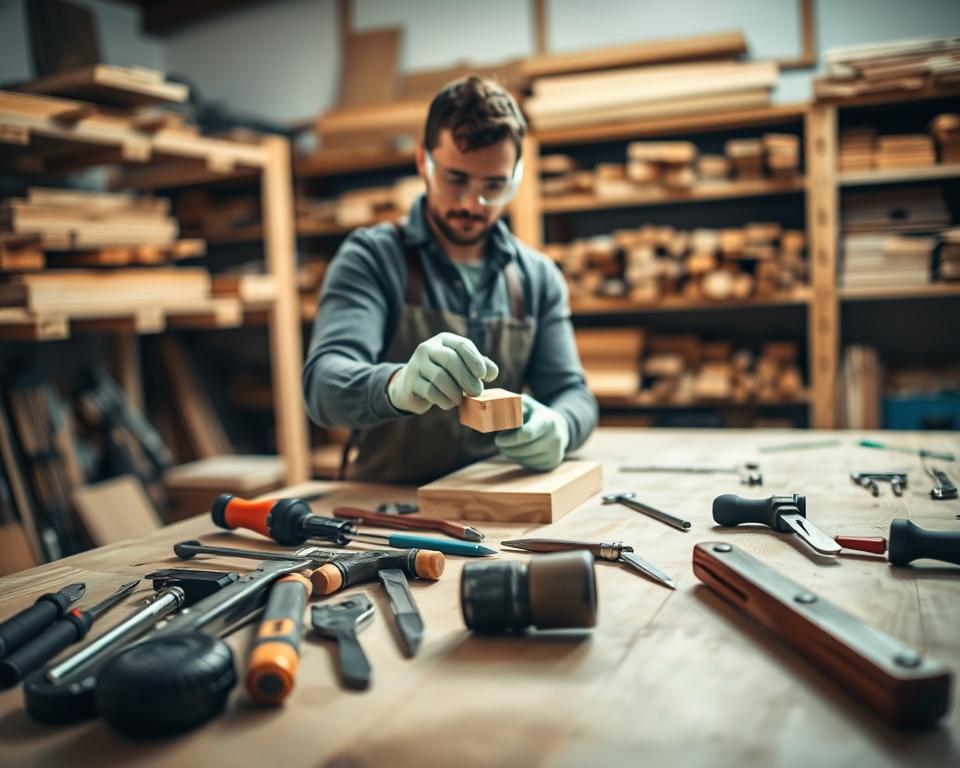
Storage and Maintenance of Tools
Keeping your woodworking tools in good shape is key to safety. By using smart storage and maintenance, you can avoid accidents and make your tools last longer. Taking care of your tools means they work better and are safer to use. A clean workspace is also crucial for safety and efficiency.
Safely Storing Your Equipment
Setting up a safe place for your tools is important. Use cabinets, wall racks, or pegboards to keep them organized and within reach. Sharp tools should be stored in protective cases to avoid cuts. Heavy tools should be on lower shelves to prevent them from falling.
Always make sure tools are secure to prevent them from falling.
Regular Tool Maintenance Tips
- Check tools often for wear and tear.
- Clean tools after each use to stop rust and buildup.
- Sharpen blades and bits often to keep them sharp.
- Oil moving parts for smooth use.
- Replace old parts quickly to keep tools safe and working.
Importance of Clean Workspaces
Keeping your workshop clean is vital for safety and getting work done well. Remove sawdust and debris often to avoid slips and improve sight. A clean space makes it easier to find tools and lowers accident risks. Clean practices help you work better and be more creative.
Fire Safety in Woodworking Spaces
Woodworking is a rewarding hobby, but it has fire risks. Knowing these dangers, taking safety steps, and having a plan can keep you safe. It’s important to stay informed and ready to enjoy your projects without fire worries.
Understanding Fire Hazards
Woodworking spaces have flammable stuff like sawdust and chemicals. Not taking care of these can increase fire risks. It’s key to clean up dust and store flammable things safely.
Best Practices for Fire Prevention
Good fire safety in your workspace is crucial. Here are important steps to follow:
- Keep your area clean to avoid sawdust and flammable stuff.
- Use dust collection systems to reduce dust that could catch fire.
- Store flammable liquids in safe containers, away from heat and flames.
- Have smoke detectors and fire extinguishers ready, making sure they’re easy to reach.
Creating an Emergency Plan
Having a good emergency plan for woodworkers is vital. Here are steps to take:
- Know all exits in your workspace and make sure they’re clear.
- Choose a meeting spot outside your building for everyone if you need to leave.
- Do fire drills regularly to make sure everyone knows what to do.
- Tell your family or co-workers about your plan so they’re ready too.
Dealing with Wood Dust
Wood dust can be harmful to those who work with wood. It’s important to know the dangers of wood dust to stay safe. Issues like breathing problems and skin irritation can happen from too much exposure.
By taking steps to protect yourself, you can enjoy woodworking more. It makes the work safer and more fun.
Health Risks Associated with Wood Dust
Breathing in wood dust can cause health problems. This includes issues like asthma and bronchitis. Hardwoods can also cause allergic reactions and skin irritation.
Long-term exposure can lead to serious health issues. So, it’s crucial to focus on safety while working.
Ways to Minimize Dust Production
Reducing wood dust is key to a clean and safe workspace. Here are some ways to do it:
- Use sharp tools for clean cuts that make less dust.
- Try techniques that lower friction when cutting or sanding.
- Use dust management systems, especially with power tools.
These methods help cut down on dust and make your work area better.
Effective Dust Collection Systems
Getting a good dust collection system is vital for a healthy workshop. High-quality systems catch and filter wood dust, lowering your risk. You can find portable units or bigger setups for larger spaces.
No matter the size of your workshop, a dust collection system is a smart choice. It’s a big step towards keeping you safe and healthy.
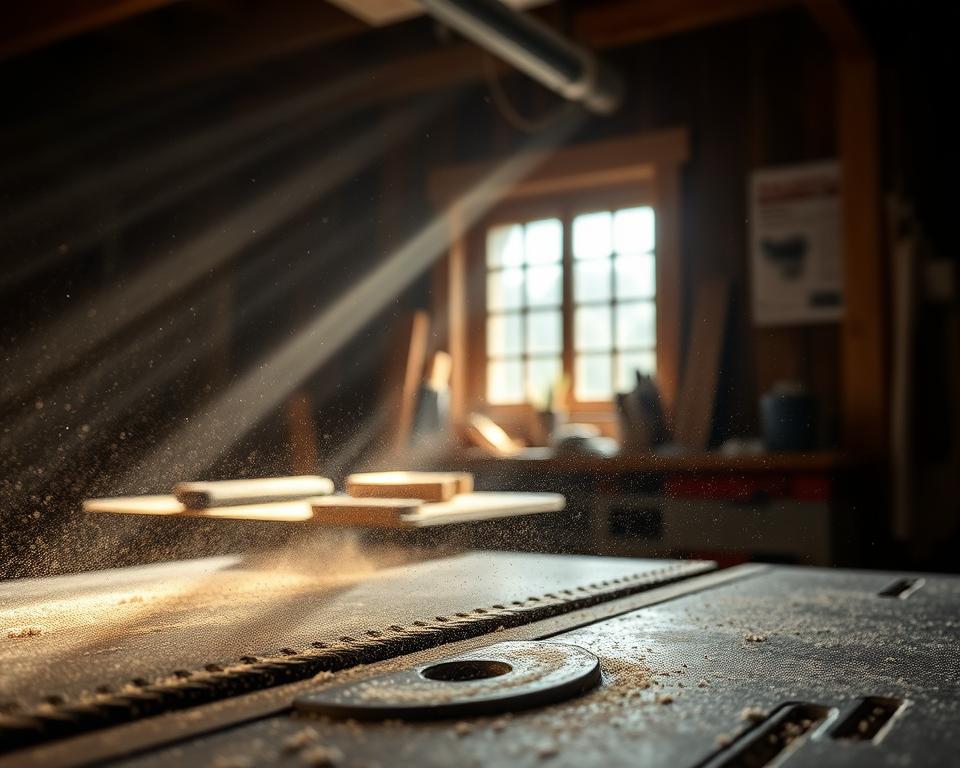
Electrical Safety Considerations
Working with power tools means you need to know about electrical safety in woodworking. It’s key to avoid accidents. Managing electrical parts right makes you work better and stay safe.
Knowing about electrical dangers helps make your woodworking safer. It’s all about being careful with electricity.
Understanding Electrical Risks
There are many ways electrical hazards can happen. Damaged cords, bad connections, and too much power on circuits are some. Spotting these dangers early helps prevent problems.
Check cords and plugs often for damage. This simple step can save you from big injuries. Knowing about electrical safety is very important.
Using Extension Cords Safely
Choosing the right extension cord is important. Make sure it fits the tool you’re using. Don’t overload cords with too many plugs.
Use outdoor cords for outdoor work to handle the weather. Keep cords dry to avoid shocks. A tidy workspace is safer and less likely to cause trips.
Grounding Your Equipment
Grounding tools is a big part of electrical safety. Use tools with three-prong plugs for grounding. Make sure your outlets are grounded too.
This stops dangerous electrical shocks. Knowing how to ground your tools lets you work safely. It’s all about reducing risks while making your projects.
First Aid Basics for Woodworking
Woodworking is rewarding but safety is key. Knowing basic first aid can help with injuries. Keep a first aid kit handy to be ready for accidents.
Essential First Aid Supplies
A good first aid kit is crucial for woodworkers. Here’s what you need:
- Adhesive bandages of various sizes
- Antiseptic wipes or solution
- Gauze pads and adhesive tape
- Antibiotic ointment
- Scissors and tweezers
- Instant cold packs
- Pain relievers like ibuprofen or acetaminophen
- Burn cream
Common Injuries and Treatments
Knowing common injuries and how to treat them is important:
| Injury | Treatment |
|---|---|
| Cuts | Clean the area, apply antiseptic, cover with a bandage. |
| Splinters | Use tweezers to remove, clean the area, and apply antiseptic. |
| Burns | Run under cold water, cover with a burn dressing, seek medical help if severe. |
| Eye Injuries | Rinse with clean water for at least 15 minutes and seek professional help immediately. |
When to Seek Professional Help
Not all injuries can be treated at home. Knowing when to seek medical help is important:
- If a cut is deep or won’t stop bleeding.
- In case of severe burns or eye injuries.
- If you notice any signs of infection, such as redness or swelling.
- When dealing with a severe allergic reaction.
Joining Craft Fair Wood Items with Safety
As you finish your wood items for the craft fair, safety is key. The final touches can make your creations last longer and look better. Make sure your wood is finished well to avoid splinters and keep customers safe.
Importance of Finished Wood Surfaces
Choosing safe wood finishes is important for a good look and protection. A well-finished surface feels great and shows off the wood’s beauty. This detail can make your work stand out and show your customers you care about quality.
Choosing Safe Adhesives
When putting your craft together, pick non-toxic adhesives. This keeps people safe and the environment clean. Look for adhesives with low or no VOCs. Always test a small area first to make sure it works with your wood.
Ensuring Stability in Displayed Items
Keeping your displays stable is crucial to avoid accidents. Use strong bases or supports to prevent items from falling. Consider adding weights to heavy displays and secure parts together. This makes your displays safe and welcoming for buyers.

